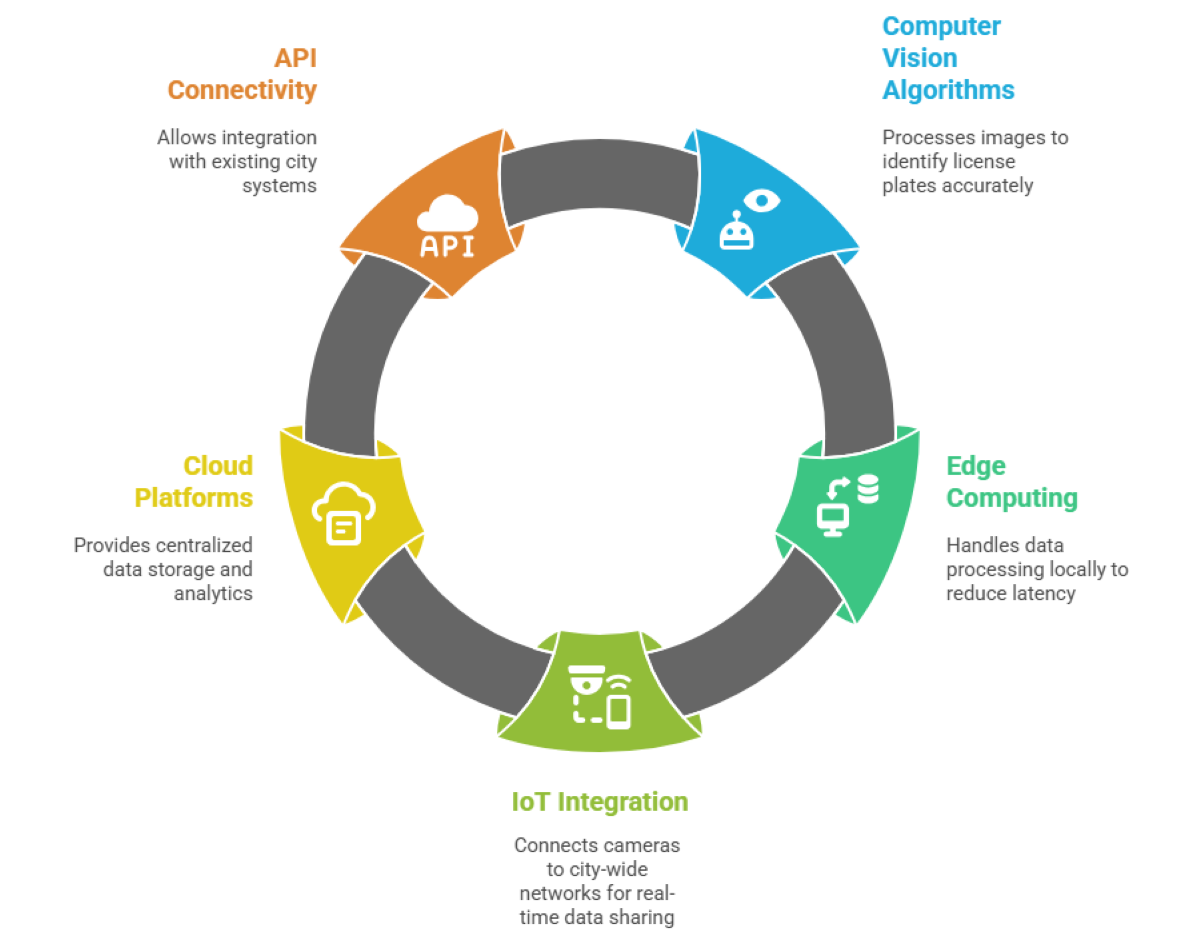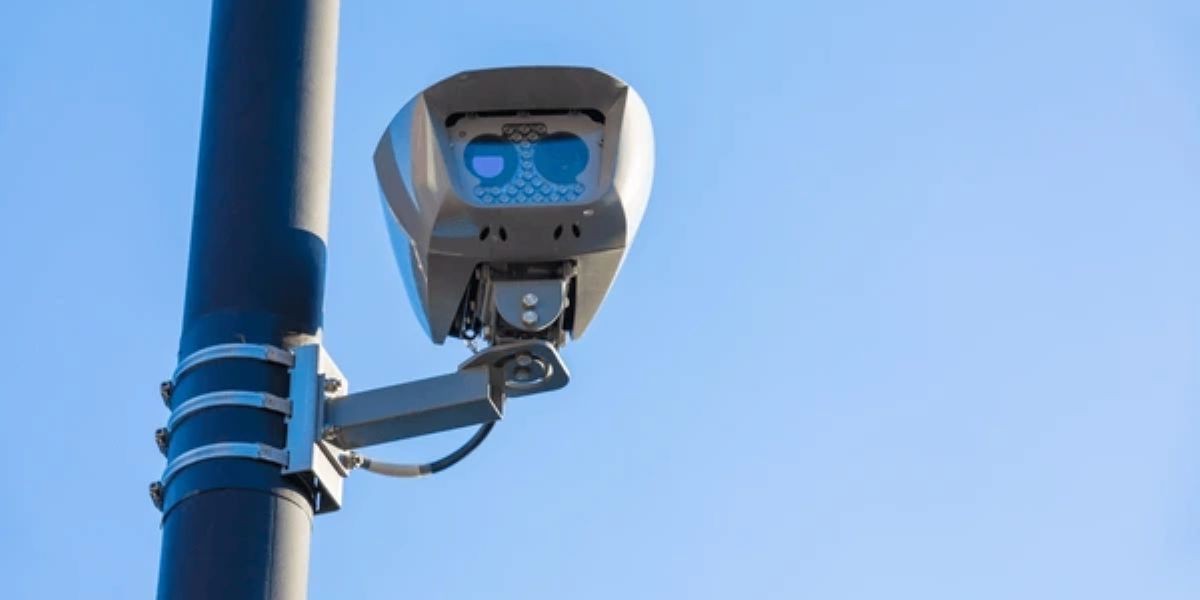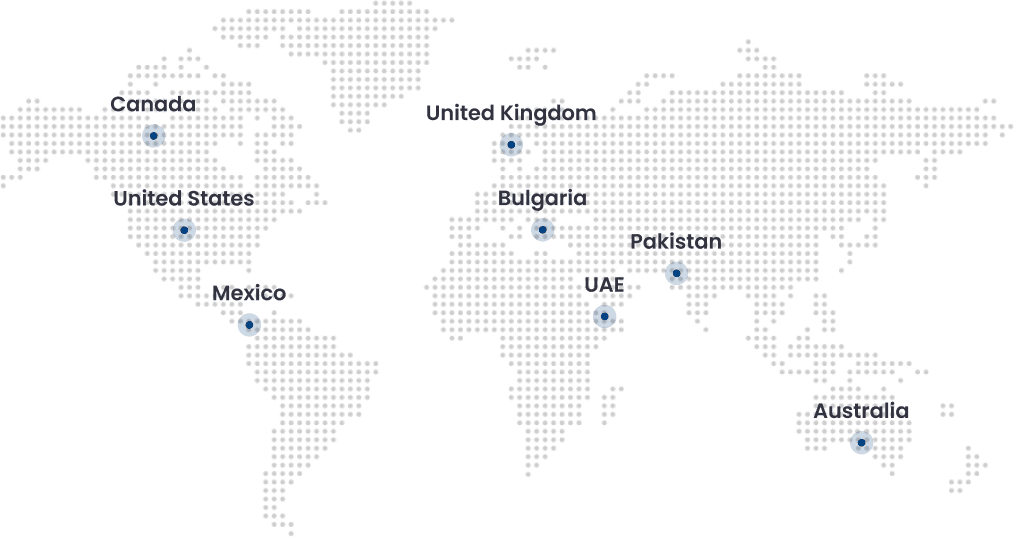American cities are quietly transforming their streets into intelligent networks. Automatic license plate recognition (ALPR) technology drives this change, turning ordinary traffic cameras into powerful tools for urban management. According to the Police Executive Research Forum, over 71% of USA police departments now utilize some form of ALPR technology, altering how municipalities approach traffic control, public safety, and urban planning.
From New York’s congestion pricing initiatives to Atlanta’s stolen vehicle recovery programs, ALPR smart city solutions in the USA are transforming the way American urban centers operate. Beyond simply reading license plates, these systems enable smarter traffic management, automated enforcement, and data-driven city planning that saves money while improving services for residents.
ALPR smart city solutions in the USA: working process
The ALPR smart city solutions in the USA follow five critical stages that convert vehicle images into actionable intelligence for city management.
- High-resolution cameras capture clear images of license plates from various angles and distances, even in challenging weather conditions like rain, snow, or fog, ensuring consistent performance throughout different seasons.
- Optical character recognition (OCR) software processes these images, converting visual characters into digital text that computers can analyze and search through databases, achieving accuracy rates exceeding 95% in optimal conditions.
- Database matching systems compare extracted plate numbers against multiple law enforcement and municipal databases, triggering alerts when matches occur with wanted vehicles, stolen cars, or traffic violation records.
- Real-time processing occurs within milliseconds, enabling immediate alerts to be sent to patrol officers and traffic management centers, allowing for swift responses to incidents, emergencies, or security threats across the city.
- Data storage systems archive plate reads with timestamps and GPS coordinates for forensic analysis and traffic pattern studies by city planners, helping optimize infrastructure and resource allocation decisions.
Types of ALPR systems
Cities deploy three main types of ALPR systems depending on their specific needs and budget constraints.
Fixed ALPR cameras
Fixed ALPR cameras mount permanently on traffic poles, bridges, or buildings, monitoring specific locations like highway entrances, downtown districts, or school zones while providing 24/7 surveillance and data collection capabilities.
Mobile ALPR units
Mobile ALPR units attach to police vehicles, allowing officers to scan plates while on patrol throughout their assigned areas and neighborhoods, increasing coverage and flexibility for law enforcement operations.
Portable ALPR systems
Portable ALPR systems offer flexibility for temporary deployments during events or construction projects that require enhanced monitoring capabilities without permanent infrastructure changes, supporting special operations and seasonal requirements.
Hybrid deployments
Hybrid deployments combine fixed and mobile units to create detailed coverage across entire metropolitan areas and jurisdictions, ensuring maximum effectiveness while balancing cost efficiency with operational coverage needs.
Key technical components

Modern ALPR systems rely on several interconnected technologies that work together seamlessly.
Computer vision algorithms
Computer vision algorithms process images to identify license plates, even in challenging conditions such as rain, snow, or low-light situations, utilizing artificial intelligence to enhance accuracy and minimize false positives.
Edge computing
Edge computing handles data processing locally, reducing latency and bandwidth requirements while improving system responsiveness and reliability for real-time operations, minimizing dependence on cloud connectivity for critical functions.
IoT integration
IoT integration connects ALPR cameras to city-wide networks, enabling real-time data sharing between departments and systems for coordinated responses, creating interconnected smart city infrastructure that improves overall efficiency.
Cloud platforms
Cloud platforms provide centralized data storage, analytics capabilities, and remote system management for municipal IT departments managing multiple camera networks, offering scalability and advanced reporting features for administrators.
API connectivity
API connectivity allows integration with existing city systems, including traffic management, parking enforcement, and emergency response platforms for streamlined operations, ensuring compatibility with legacy systems and future technology upgrades.
Market trends & growth in the USA
The American smart city market is experiencing unmatched growth, driven by federal infrastructure investments and local modernization initiatives.
- Federal infrastructure investment has surged across the United States, with the Biden administration’s Infrastructure Investment and Jobs Act allocating billions toward urban technology upgrades and smart city development projects.
- ALPR market growth shows a compound annual growth rate of 27% through 2030, making it one of the fastest-growing segments in smart city technology adoption across American municipalities.
- Major city deployments include New York, Chicago, San Diego, and Austin, which are expanding their ALPR systems with thorough coverage plans that span entire metropolitan areas and surrounding counties.
- Private sector expansion led by companies like Flock Safety has installed cameras in over 5,000 American communities, creating the largest civilian ALPR network in the country’s history.
- Federal grant programs through the Department of Transportation are funding ALPR pilot programs in mid-sized cities, democratizing access to advanced traffic management technology previously limited to large municipalities.
Comparing USA vs global adoption
American cities can learn valuable lessons from international ALPR deployments while leveraging unique domestic advantages.
- European models like London’s congestion pricing since 2003 provide proven frameworks for American cities considering similar traffic management and revenue generation programs.
- Asian integration, demonstrated by Singapore, shows comprehensive smart city platforms where ALPR connects with broader urban management systems for holistic city operations.
- American advantages include extensive vehicle registration databases, established public-private partnerships, and federal funding programs that support widespread technology adoption across municipalities.
- Standardized infrastructure benefits from uniform license plate formats across states and robust data-sharing agreements between jurisdictions, enabling seamless multi-state tracking capabilities.
- Public-private flexibility enables companies like Flock Safety to deploy cameras in residential neighborhoods, sharing data with law enforcement to create comprehensive coverage networks.
Core applications of ALPR in the USA’s smart cities

Different cities are discovering that ALPR smart city solutions in the USA effectively address multiple urban challenges at once.
Traffic management & congestion control
ALPR systems monitor vehicle flow patterns and identify bottlenecks in real-time. Cities use this data to adjust traffic light timing, reroute vehicles during peak hours, and plan infrastructure improvements. San Francisco’s Municipal Transportation Agency uses ALPR data to optimize bus routes and reduce delays. Modern AI vehicle detection systems enhance these capabilities by providing detailed traffic analytics.
Automated toll collection & road pricing
Electronic toll collection has become standard on American highways, with ALPR eliminating the need for physical toll booths. States like Texas and Florida have converted entire highway systems to ALPR-based tolling. New York City is piloting congestion pricing in Manhattan using ALPR cameras to charge vehicles entering busy districts.
Parking management (public & private)
ALPR transforms parking enforcement from manual meter checking to automated monitoring. Cities like Los Angeles use ALPR-equipped vehicles to scan entire neighborhoods in minutes. Private parking operators integrate ALPR with mobile apps, allowing customers to pay remotely and receive notifications before tickets are issued.
Law enforcement & stolen vehicle detection
Police departments rely on ALPR for locating stolen vehicles and tracking suspects. The technology provides real-time alerts when wanted vehicles pass cameras, dramatically reducing response times. Atlanta Police Department reported a 40% increase in stolen vehicle recovery rates after implementing city-wide ALPR networks.
Environmental zones & low-emission area monitoring
Some American cities are testing ALPR for environmental compliance monitoring. Seattle utilizes ALPR to track emissions from commercial vehicles in downtown areas. California’s Air Resources Board is exploring the integration of ALPRs with vehicle registration databases to identify high-polluting vehicles.
Benefits of ALPR in the USA’s urban management
American cities implementing ALPR systems report measurable improvements across multiple areas of municipal operations and citizen services.
- Enhanced public safety comes from faster response times to emergencies and improved tracking of suspicious vehicles across city-wide networks, helping US law enforcement agencies coordinate responses between jurisdictions and departments.
- Reduced traffic congestion results from better traffic flow management and optimized routing recommendations that help American cities distribute vehicle loads more efficiently during peak commuting hours and special events.
- Streamlined revenue collection eliminates manual processes for parking tickets, toll collection, and traffic fines while reducing administrative costs and human error in the US municipal finance departments and court systems.
- Real-time traffic intelligence helps American city planners make data-driven decisions about infrastructure investments and traffic patterns using comprehensive analytics that support federal grant applications and state funding requests.
- Improved municipal efficiency emerges from automated enforcement and reduced personnel costs, allowing US cities to reallocate resources toward community services while maintaining effective traffic and parking management programs.
Key challenges in ALPR implementation in the USA
However, ALPR offers considerable merits; American cities face unique challenges when implementing these systems, which require thoughtful planning and community engagement.
- Privacy concerns dominate public discussions about ALPR expansion, with state laws varying widely on data retention requirements and citizen surveillance rights.
- Infrastructure limitations in older cities create deployment challenges, as many areas lack the power and network connections needed for modern systems.
- High deployment costs can strain municipal budgets, with city-wide systems requiring millions in initial investment plus ongoing maintenance expenses.
- Weather and lighting conditions affect accuracy rates, although modern systems perform better in challenging environments by utilizing advanced imaging and processing technology.
- Public acceptance issues arise from community concerns about surveillance overreach, requiring transparent policies and citizen education programs for successful implementation.
Future of ALPR in the USA
American cities are positioning themselves to lead global smart city innovation through next-generation ALPR technologies and federal infrastructure investments.
Federal infrastructure modernization
The Biden administration’s $1.2 trillion Infrastructure Investment and Jobs Act will accelerate ALPR adoption across thousands of American municipalities, creating standardized smart city networks from coast to coast.
AI-powered border security integration
Municipal ALPR networks will connect with federal databases, enabling seamless tracking of vehicles across state lines while supporting national security initiatives and interstate crime prevention efforts.
5G smart city networks
American cities will deploy dense ALPR camera arrays with ultra-low latency processing, supporting real-time traffic coordination and emergency response systems that exceed current global standards for urban intelligence.
Electric vehicle integration
ALPR capabilities will expand to monitor charging station usage, track emission compliance in environmental zones, and support state-level clean air initiatives as American cities transition toward sustainable transportation.
Public-private partnership expansion
Deployment will accelerate through companies like Flock Safety and municipal partnerships, creating the world’s largest civilian ALPR network while maintaining American leadership in smart city technology development.
How Folio3 can help in smart ALPR solutions for the USA
Folio3’s ALPR smart city solutions in the USA integrate seamlessly with existing municipal systems, offering advanced vehicle counting to help cities optimize traffic flow and infrastructure planning.
AI-Powered detection
Folio3’s system achieves over 90% accuracy in license plate recognition across all 50 US state plate formats and various weather conditions, using machine learning algorithms trained specifically on American vehicle types and road conditions.
Real-time tracking
The platform provides instant alerts through cloud-based dashboards with customizable geofencing options, enabling immediate response to security incidents and traffic violations while maintaining compliance with state-specific data retention laws.
Municipal system integration
Folio3’s solution works seamlessly with existing CCTV networks, IoT sensors, smart traffic poles, and American municipal management platforms, eliminating the need for complete infrastructure replacement in budget-conscious US cities.
Frequently asked questions
What is ALPR, and how is it used in smart cities?
ALPR (Automatic License Plate Recognition) uses cameras and computer vision to read vehicle license plates automatically. Smart cities use ALPR for traffic management, parking enforcement, toll collection, and public safety applications.
Is ALPR legal in the USA?
Yes, ALPR is legal in the United States, though regulations vary by state. Most states require law enforcement agencies to have policies governing data retention and privacy protection when using ALPR systems.
How does ALPR improve urban traffic and parking?
ALPR provides real-time data on vehicle movements, enabling cities to optimize traffic light timing, identify congestion patterns, and enforce parking regulations more efficiently than manual methods.
Can ALPR systems be integrated with smart city platforms?
Modern ALPR systems are designed for integration with existing smart city infrastructure, including traffic management systems, IoT networks, and municipal databases through standard APIs and protocols.
What cities in the USA are using ALPR solutions?
Major American cities, including New York, Los Angeles, Chicago, San Francisco, Atlanta, and thousands of smaller communities, use ALPR technology for various municipal applications from traffic management to public safety.

Laraib Malik is a passionate content writer specializing in AI, machine learning, and technology sectors. She creates authoritative, entity-based content for various websites, helping businesses develop E-E-A-T compliant materials with AEO and GEO optimization that meet industry standards and achieve maximum visibility across traditional and AI-powered search platforms.











